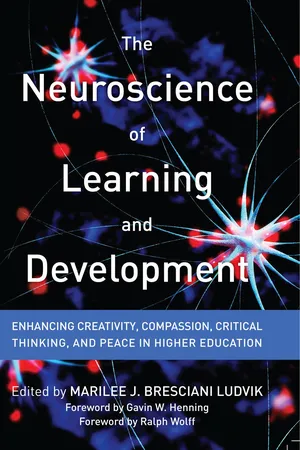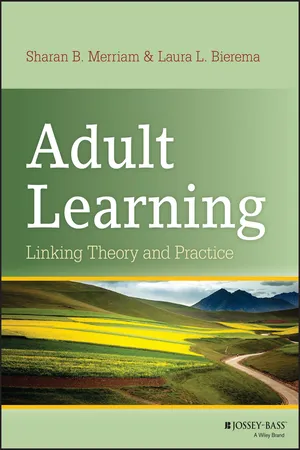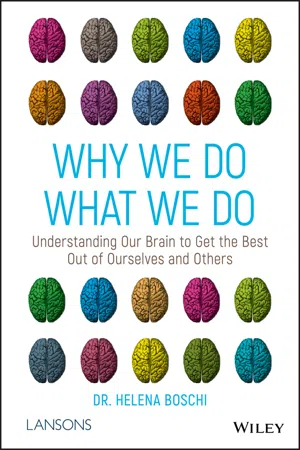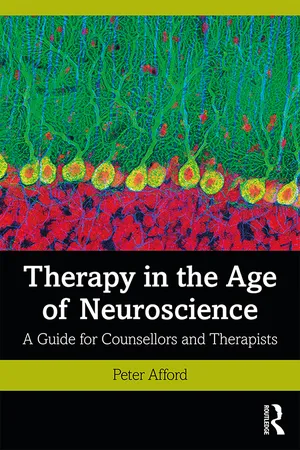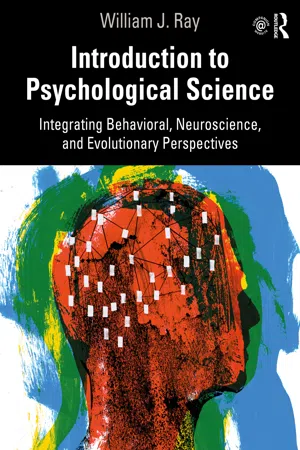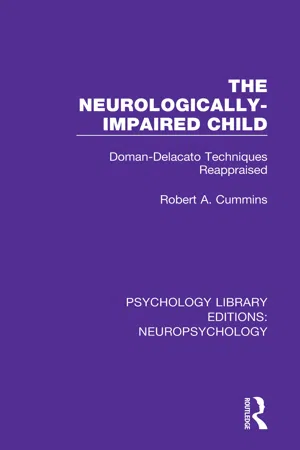Psychology
The Brain
The brain is the central organ of the human nervous system, responsible for processing information, controlling behavior, and regulating bodily functions. It is composed of billions of neurons that communicate through electrical and chemical signals. Different regions of the brain are specialized for various functions, such as sensory perception, motor control, language processing, and emotional regulation.
Written by Perlego with AI-assistance
Related key terms
Related key terms
1 of 4
Related key terms
1 of 3
12 Key excerpts on "The Brain"
- eBook - ePub
Psychological Criminology
An Integrative Approach
- Richard Wortley(Author)
- 2023(Publication Date)
- Routledge(Publisher)
Examined in this chapter is the pivotal role in criminal behaviour played by The Brain as it mediates between internal biological inputs and external environmental inputs. The area of psychology concerned with brain structure and function is neuropsychology. Neuropsychologists examine the biological events in The Brain that underlie human action, emotion and thought, including those associated with criminal behaviour. They are concerned with both normal brain structures and functions, and with the behavioural implications of brain impairments. We begin with an overview of the general field of neuropsychology, before moving to a more specific discussion of neuropsychological correlates and explanations of criminal behaviour.Basic brain structures and functions
Neuropsychology, like behavioural genetics, is a specialist field and it is beyond the scope of this book to cover it in detail here. What follows, then, is a simplified description of basic brain structures and functions that are especially relevant to neuropsychological explanations of crime; namely, the nervous system, biochemical messengers, brain anatomy, and environmental impacts on brain development.The nervous system
The Brain is part of the body’s nervous system, a network of nerve cells – or neurons – that is responsible for all psychological, behavioural, and physiological activity. The basic job of a neuron is to relay information. Neurons come in a variety of shapes and have different specialised functions, but most comprise four main structures. The body of the neuron is called the soma and houses the basic machinery of the cell. Extending from the soma are tree-like fibres – hundreds or even thousands in number – called dendrites, which have receptors responsible for receiving messages from other neurons. Also extending from the soma is a slender tube called an axon, which is responsible for sending messages. The axon divides and branches, and at the ends of the branches are terminal buttons from which the messages are sent. A simplified diagram of a neuron is shown in Figure 4.1.Figure 4.1A neuron.The nervous system is divided into two parts – the central nervous system (CNS) and the peripheral nervous system (PNS) (see Figure 4.2 - eBook - ePub
Psychological Criminology
An Integrative Approach
- Richard Wortley(Author)
- 2011(Publication Date)
- Willan(Publisher)
Examined in this chapter is the pivotal role in criminal behaviour played by The Brain as it mediates between internal biological inputs and external environmental inputs. The area of psychology concerned with brain structure and function is neuropsychology. Neuropsychologists examine the biological events in The Brain that underlie human action, emotion and thought, including those associated with criminal behaviour. They are concerned with both normal brain structures and functions, and with the behavioural implications of brain impairments. We begin with an overview of the general field of neuropsychology, before moving to a more specific discussion of neuropsychological correlates and explanations of criminal behaviour.Basic Brain Structures and FunctionsNeuropsychology, like behavioural genetics, is a specialist field and it is beyond the scope of this book to cover it in detail here. What follows, then, is a simplified description of basic brain structures and functions that are especially relevant to neuropsychological explanations of crime.The Nervous SystemThe Brain is part of the body’s nervous system, a network of nerve cells – or neurons – that is responsible for all psychological, behavioural and physiological activity. The basic job of a neuron is to relay information. Neurons come in a variety of shapes and have different specialised functions, but most comprise four main structures. The body of the neuron is called the soma and houses the basic machinery of the cell. Extending from the soma are tree-like fibres – hundreds or even thousands in number – called dendrites, which have receptors responsible for receiving messages from other neurons. Also extending from the soma is a slender tube called an axon, which is responsible for sending messages. The axon divides and branches, and at the ends of the branches are terminal buttons from which the messages are sent. A simplified diagram of a neuron is shown in Figure 4.1.Figure 4.1A neuron.The nervous system is divided into two parts: the central nervous system (CNS) and the peripheral nervous system (PNS) (see Figure 4.2). The CNS comprises The Brain and the spinal cord and is the body’s ‘command centre’. The Brain receives and processes stimuli from inside and outside of the body, it interprets and stores information, and it dispatches messages to initiate responses. The spinal cord is connected to the base of The Brain and primarily acts as a conduit between The Brain and the rest of the body below the neck. - eBook - ePub
The Neuroscience of Learning and Development
Enhancing Creativity, Compassion, Critical Thinking, and Peace in Higher Education
- Marilee J. Bresciani Ludvik, Marilee J. Bresciani Ludvik(Authors)
- 2016(Publication Date)
- Stylus Publishing(Publisher)
1 BASIC BRAIN PARTS ANDTHEIR FUNCTIONS Matthew R. Evrard, Jacopo Annese, and Marilee J. Bresciani Ludvik with review by Mark Baxter and Thomas Van VleetEverything we do, every thought we’ve ever had, is produced by the human brain. But exactly how it operates remains one of the biggest unsolved mysteries, and it seems the more we probe its secrets, the more surprises we find.—Neil deGrasse Tyson (www.brainyquote.com/quotes/quotes/n/neildegras531089.html )M any of the traditional student learning and development theories used in higher education are based in developmental theories in psychology and cognitive neuroscience, along with a number of other disciplines (Ansari & Coch, 2006; Coch & Ansari, 2009; Goswami, 2006; Meltzoff, Kuhl, Movellan, & Sejnowski, 2009). With emerging findings, educational neuroscientists are affirming previous assumptions about The Brain’s role in reading, numerical comprehension, attention, and particular types of learning disabilities such as dyslexia and attention deficit/hyperactivity disorder (Ansari, 2008; Carey, 2014; Davis, 2004; Gabrieli, 2009; Howard-Jones, Pickering, & Diack, 2007; McCandliss & Noble, 2003; Petitto & Dunbar, 2004; Price, Holloway, Räsänen, Vesterinen, & Ansari, 2007). The fascination with The Brain is all around us, and so it is indeed time to intentionally incorporate neuroscience discoveries into the design, delivery, and evaluation of higher education.This chapter sets out to provide a brief framework of The Brain. We intend to describe various regions of The Brain and generalize their primary functions. But first allow me to share how I, Matthew R. Evrard, arrived at the gates of an emerging field.Have you ever had the experience of suddenly realizing a past memory—perhaps as a child or teenager—that helped explain why you are who you are? I can recall multiple memories from my early childhood where my mother took me to a store and told me to choose a gift. I always chose books on scientific theory. Such books were well above my comprehension level, but I was unyielding in my attempts to understand as much as I could. If there was a puzzle, I wanted to solve it. Memories such as these, as well as my imperishable love of science, strengthened my belief that I was born a self-challenging scientist, proudly mom-accredited. - eBook - ePub
- Lalit Kumar, Yashwant Pathak(Authors)
- 2022(Publication Date)
- Elsevier(Publisher)
Part A Anatomy and physiology of The BrainPassage contains an image
1: An overview of the anatomy and physiology of The Brain
Rashmi Bhushan; V. Ravichandiran; Nitesh Kumar Department of Pharmacology and Toxicology, National Institute of Pharmaceutical Education and Research (NIPER), Export Promotion Industrial Park (EPIP), Hajipur, Bihar, IndiaAbstract
Even though the main objective of neuroscience research is to obtain a better knowledge of The Brain, its parts and how its functions are connected to the mind and the nervous system of human beings, a majority of present efforts are aimed at answering minor issues with more comprehensive information about internal structures, physiology, and clinical implications in the central nervous system (CNS). However, if insights from these neuroanatomy and physiology studies are combined, it may be possible to satisfactorily address the wider topic of mind-brain processes. We believe that The Brain is a complicated system or network in which mental states originate through interactions at many physical and functional levels. Broad-scale conversations about the characteristics of cognition and the study of mind-brain and its components’ functioning processes will be critical to making further conceptual advances. In this chapter, we will study anatomical structures and physiological functions of different parts of the human brain and CNS.Keywords
Brain; Central nervous system; Neuroscience; Neuroanatomy; Physiology1: Nervous system
Neurons are highly specialized cells present in all animals that form structural component of their nervous system. These neurons can sense, receive, and transmit various forms of stimuli. Lower invertebrates have a very basic neural organization. In Hydra, for example, it consists of a neuronal network, whereas insects have a better-organized neural system because they possess a cortex as well as a variety of ganglia and neural tissues. Vertebrates have a more evolved nervous system than other species [1] - eBook - ePub
Adult Learning
Linking Theory and Practice
- Sharan B. Merriam, Laura L. Bierema(Authors)
- 2013(Publication Date)
- Jossey-Bass(Publisher)
CHAPTER NINE The Brain and Cognitive FunctioningAt the age of 37, brain scientist Jill Taylor had a massive stroke that left her unable to walk, talk, read, or write. In her book, My Stroke of Insight (2009), Taylor writes of the morning of her stroke, “Wow, how many scientists have the opportunity to study their own brain function and mental deterioration from the inside out?” (p. 44, italics in original). It took her eight years but she retaught her brain and today she is living a normal life and once again conducting research on the human brain. Her book is a testimony to “the beauty and resiliency of our human brain because of its innate ability to constantly adapt to change and recover function” (p. xv). Indeed, our brain is an amazing organ in our body, one that changes as we learn. In this chapter we begin with a short overview of how The Brain works, then we go on to discuss several dimensions of cognitive functioning including memory, intelligence, cognitive development, and wisdom—all with an eye to how our learning maximizes each of these functions.Brain Basics
The Brain, which is attached to the spinal cord, can be thought of as the control center of the human organism. This control center is constantly monitoring all functions within our bodies such as heart rate and breathing, in addition to what is going on immediately around the body. This outside data comes into the body through our senses—seeing, hearing, touching, tasting, and smelling. The Brain continually processes all this data, making adjustments as necessary to keep the human organism out of danger and responding appropriately to incoming data. Over the years scientists have mapped The Brain, identifying which part does what. We will now look at two of these maps—the three-part triune brain, and the two-part hemispheric brain.Figure 9.1 - eBook - ePub
Television Aesthetics
Perceptual, Cognitive and Compositional Bases
- Nikos Metallinos(Author)
- 2013(Publication Date)
- Routledge(Publisher)
On the basis of the previous information regarding the anatomy of the human brain, this chapter distinguishes the tasks performed by the various centers of the neurobiological brain from the mental activities of the invisible mind. Specifically, this chapter examines the main functions of the information centers of The Brain, discusses the specific functions of the left and right hemispheres of The Brain, and identifies both the biological and mental processes involved in recognizing the visual and auditory signals of the television picture.The Brain DIVIDED: MAIN FUNCTIONS OF The Brain’S INFORMATION CENTERSAt the outset, three important factors regarding the functions of the various parts of the human brain must be brought into focus. The Brain, as a central nervous system responsible for the appropriate functions of all other systems of the human body, is an extremely complex organ. To this day neuroscience has not been able to unveil all the complex functions of every part of The Brain, although some areas have been identified and parts of The Brain have been given specific names stemming from the functions they seemingly perform (Boddy, 1978). Second, an anatomical description of the human brain vis-à-vis the tasks performed by its parts, regardless of how well thought out and detailed, requires advance knowledge of biological, neurological, chemical, psychological, and behavioral studies, to mention only a few. Artists, scientists, neurologists, and communicators, must work on common ground and in full cooperation to unveil the complex and delicate functions of the various parts of the human brain (Frisby, 1980). Finally, the suggested scientific approach for the study of The Brain should be multilevel, combining at least the three methods suggested by Bloom et al. (1985): (a) Inductive reasoning in which the scientists and/or artists start with an observation, formulate a hypothesis, and experimentally test this hypothesis; (b) deductive reasoning in which the scientists and/or artists start with an overall idea of a phenomenon, a global hypothesis, and formulate experiments to test its truth; and (c) the analogies - eBook - ePub
Why We Do What We Do
Understanding Our Brain to Get the Best Out of Ourselves and Others
- Helena Boschi(Author)
- 2020(Publication Date)
- Wiley(Publisher)
chapter one Our Brain‘Sitting on our shoulders is the most complicated object in the known universe.’MICHIO KAKUTheoretical physicist and futurist (1947–)ABOUT THIS CHAPTER
The Brain is the basis of everything we do: how we behave, feel, remember, pay attention, create, change, influence and ultimately live. Learning about how our brain functions is an important starting point to understanding why we do what we do.Even though it only weighs around one and a half kilograms, our brain is complicated. With the advent of neuroimaging techniques we are now able to see inside The Brain and explore its function and structure in greater depth. But despite new advances in neuroscience, neurobiology and neuropsychology, The Brain remains the most mysterious, complex and relatively unknown organ in the human body.This chapter provides an introductory overview of the main structures and functions of the human brain. It explains how our brain helps us respond to the world around us and keeps our system in balance. Some insights are offered into male/female brain differences, whilst also acknowledging the influences of our environment and upbringing.As we begin to understand more about how our brain works, we become more aware of our own thoughts, responses, behaviours and emotions. We also become better equipped to get the best out of our brainpower in the future.Part 1: The science explained
The key function of our brain is to keep us alive. This means that our brain needs to be able to anticipate what is safe or harmful in our environment.In other words, our brain is our personal prediction machine. It is constantly scanning and processing the world around us to help us respond appropriately.Why we need to keep it all in balance
The Brain maintains a finely tuned internal balance in order to regulate our heartbeat, breathing, temperature, water, hormonal release and sugar levels. This internal balance is known as homeostasis, - eBook - ePub
Therapy in the Age of Neuroscience
A Guide for Counsellors and Therapists
- Peter Afford(Author)
- 2019(Publication Date)
- Routledge(Publisher)
Chapter 2The Brain is a nervous system
Introduction
The human brain is “the most complicated material object in the known universe,” says Edelman (2005: 14). Let’s not allow this to discourage us: with a little effort, complex subjects can be summarised into a comprehensible outline. I’ll begin at the beginning and explain The Brain with the aim of painting a contextual picture to underpin the rest of the book. Some technical terms are unavoidable, but I’ll aim to strike a balance and avoid unnecessary ones.You may already know some of what follows, but I recommend reading it anyway so you can follow my reasoning in later chapters.Nervous systems: the overall framework
That The Brain is a nervous system need not surprise therapists accustomed to encountering their clients’ anxieties, not to mention their own. And by describing it as a nervous system, the body is included from the outset. If you were to remove a brain from its skull, it would come with the spinal cord and a lengthy tangle of nerve endings attached. To have just The Brain that sits in the head, you’d need a sharp knife to separate it from what sits below in the body. Evolution found it practical to keep the main lump of neural jelly safely encased in its protective skull, close to eyes and ears and well away from everything else sloshing around in the body. So really The Brain is a part of the nervous system, which sub-divides into constituent elements as follows (see Figure 2.1 ).Figure 2.1 Nervous systems: the central nervous system consists of The Brain and spinal cord, the peripheral nervous system extends to every nook and cranny of the bodyThe central nervous system - eBook - ePub
- Mark J. Cain(Author)
- 2015(Publication Date)
- Polity(Publisher)
6The Brain and Cognition1 Introduction
What is the relationship between The Brain and the mind or between neural states and processes and cognitive states and processes? And what are the implications of the nature of that relationship for the role of the study of The Brain in cognitive science? The purpose of this chapter is to address these questions in the light of recent developments in neuroscience and the rising prominence of that discipline both in the scientific community and in the popular imagination.2 Neuroscience and the history of cognitive science
As we saw in chapter 1 , cognitive science was founded on the basis of the rejection of substance dualism and of behaviourism. Accordingly, the mind was viewed as a physical system internal to the body that mediated the connections between the world external to the body and bodily behaviour or action. Thus, for example, when a wild animal approaches a person and they respond by throwing a stone in the animal’s direction, that response is mediated by processes internal to the body that serve to identify the wild animal and work out the best way to respond to it given the person’s current goals. As a result of this processing, instructions are issued to the motor control systems so that the person behaves in line with their plans. It was also a foundational assumption of cognitive science that such internal processes take place in The Brain, that The Brain is the seat of cognition. Given this, one might have expected that neuroscience, the scientific study of The Brain, would have played a prominent role in cognitive science throughout its history. However, this has not been the case for several reasons.The first reason why neuroscience has had only a limited role in the history of cognitive science is a practical one. Neuroscientists often point out that the human brain is the most complex system in known existence, being made up of 100 billion neurons, most of which are connected to thousands of other neurons, giving rise to a system with 100 trillion internal connections. This complexity makes the human brain a very difficult system to study. Not surprisingly, our scientific understanding of the workings of The Brain has historically lagged way behind that of our understanding of other aspects of the natural world. The upshot of this is that, for most of the history of cognitive science, neuroscientists haven’t known enough about the workings of The Brain to make much of a contribution. However, things are rapidly changing on this front, in no small part on account of the emergence of technologies that enable us to scan the human brain. - eBook - ePub
Introduction to Psychological Science
Integrating Behavioral, Neuroscience and Evolutionary Perspectives
- William J. Ray(Author)
- 2021(Publication Date)
- Routledge(Publisher)
For example, when we see a bear in the woods, our heart rate speeds up as we prepare to avoid danger. The chapter on stress and health will describe the peripheral nervous system (PNS) and how the body reacts to fear and stress, while this chapter will focus on the central nervous system and its major component, The Brain. Many of the topics covered in this chapter, such as parts of The Brain, neurotransmitters, and the function of neurons, are available in two-minute videos (www.neurochallenged.com). Figure 3-3 Divisions of the nervous system. Neurons Santiago Ramón y Cajal (1852–1934), often considered the father of modern neuroscience, was the first to theorize that the nervous system is made up of individual cells. He identified these cells as separate components of the nervous system. These specialized cells are neurons, single nerve cells that can transmit information to other neurons. Neurons are central to all brain processes, and are the basis for The Brain’s communication with the rest of the body. Neurons—all 86 billion of them—play important roles in learning as well as in transferring information in The Brain (Azevedo et al., 2009). If you turn your head, specific neurons are active in your brain. If you feel excited, other neurons are active. Even the act of remembering the fact that there are 86 billion neurons in your brain involves another set of neurons. Amazingly, the neuron has remained the basic building block of organisms over millions and even billions of years of evolution. Almost all living types of organisms, except some like the sponge or slime mold, have neurons. Neurons are found in the nervous systems of animals ranging from insects to humans. In general, humans have 100,000 neurons in a cubic millimeter of The Brain, which is one millimeter on each side (Fried, Rutishauser, Cerf, & Kreiman, 2014). Figure 3-4 Scale showing size of a millimeter - eBook - ePub
Naturalism and the Human Condition
Against Scientism
- Frederick A. Olafson(Author)
- 2003(Publication Date)
- Routledge(Publisher)
5What does The Brain do?
I
Up to this point, the line of argument I have been developing has addressed themes that are, in considerable measure, peculiar to contemporary naturalism. They are, as has already been noted, not the sort of thing that preoccupied the minds of classical materialists like Democritus or Hobbes. Now, however, it is time to turn to an aspect of the naturalistic approach to the philosophy of mind that would probably have struck those thinkers as being completely in line with their own way of conceiving materialism. This is the effort to show that the mind itself is physical in nature, a part of the body. It is, in short, The Brain and The Brain as neuroscience describes it.There has recently been a strong uptake of interest in The Brain on the part of philosophers, undoubtedly in good part as a result of the progress that is being made by neuroscientists in exploring the anatomy and functional organization of that organ. This has raised hopes on the part of a number of philosophers that this work may have reached a point at which it can contribute something of value to the analysis of issues in the philosophy of mind. Interest in the potential relevance of neuroscientific inquiries has become quite widespread and has reached a point where a degree of familiarity with the physiology of The Brain and with the current state of research into its functions is commonly thought to be a pre-requisite for philosophers hoping to work in what is now called “cognitive science.”I do not myself have this kind of familiarity with contemporary neuro-science or cognitive science and so this chapter will offer a distinctly external perspective on those fields of inquiry. My justification for trespassing on this territory lies in the fact that there is an issue of paramount importance to this whole enterprise that can fairly be posed by those who stand outside or on the margins of current developments. Plainly, any judgment on the relevance of brain research to philosophy and to what it has to say about human beings must rest on assumptions about what it is that The Brain is supposed to do. Although it might seem that this is the most elementary question that could possibly be posed to researchers in this field and that an answer to it must be ready and waiting for those who pose it, that turns out not to be the case. There is no generally accepted answer to this question that has a clear bearing on this matter of relevance; and the ones that are given are anything but transparently valid. This is what I want to show in this chapter. I will also argue that as long as this situation holds, the pretty well universal conviction that we could not think or feel or perceive if we had no brain cannot be cited, as it so often is, as a knock-down argument for hard naturalism. - eBook - ePub
The Neurologically-Impaired Child
Doman-Delacato Techniques Reappraised
- Robert A. Cummins(Author)
- 2018(Publication Date)
- Routledge(Publisher)
Fundamental Neuroanatomy. Freeman, New York.Rosenzweig, M.R. and Leiman, A.L., 1982, Physiological Psychology. D.C. Heath and Company, Lexington, Mass.(a) AN INTRODUCTION TO The Brain
One of the best ways of understanding brain structure and function is to trace through the evolutionary (phylogenetic) stages of brain development. Our knowledge of this process is now sufficiently refined to allow for an explanation of human brain construction in these terms. To start this analysis a word needs to be said about the universal unit of biological construction, the cell.(i) The Cell
All living matter, both plants and animals, is composed of discrete units called cells. A simplified cell is depicted in Figure 2.1 where three essential components are identified as:- Cell membrane: this extremely thin membrane completely surrounds the cell thereby delimiting the cell boundary. This structure is a semi-porous barrier allowing some chemicals to flow quite readily either into or out of the cell while blocking the passage of others. Through this barrier the cell is in controlled chemical contact with its immediate environment.
- Cytoplasm: is a viscous fluid which comprises the interior of the cell. Within this fluid the cell carries out the chemical reactions necessary for life.
- Nucleus: herein lies the genetic material of the cell. Chemically coded instructions are held on the long strands of DNA that make up the chromosomes.
Figure 2.1 A cell(ii) Brain Cells
Cells making up The Brain are called neurons. A typical neuron is shown in Figure 2.2
Index pages curate the most relevant extracts from our library of academic textbooks. They’ve been created using an in-house natural language model (NLM), each adding context and meaning to key research topics.
Explore more topic indexes
Explore more topic indexes
1 of 6
Explore more topic indexes
1 of 4


